May 24
A beautiful day today - bright and sunny. Breakfast was quite good -- we had the same server as we did for dinner last night. My opinion of the hotel as shabby is just reinforced by the stained ceiling tiles and the fact that the glass is missing from every single light fixture e in the dining room -- just brass frames that obviously should have glass panels in them, but are just bare bulbs. Oh, well.
We passed an interesting sign: A surprise sign (minus the !) and "sudden gunfire". It was startling enough that we actually stopped. Wha? Really? A nearby sign explains it: Kirkcudbright Training Area -- some sort of military base, we figured. But the sign sure stopped us in our tracks.
By the way, I got some surprised looks when I managed to pronounce Kirkcudbright correctly -- kirk-uh-bree. Only because I'd heard it pronounced before, of course, but the locals are so used to having it mangled horribly that ai actually got a comment for doing it right. I still can't get over Alnwick being 'ann-ick', though. Some pronunciations took a bit to get right -- Craigallache (Creaig-AL-akee) is still in my head as 'creg-a-LACK-ee', no matter what I do. We always get the stress wrong when we try a new town name -- they don't follow the rules for English because most of them are Gaelic, or derived from the Gaelic. It's better than me trying to pronounce French, though, so I shouldn’t complain.
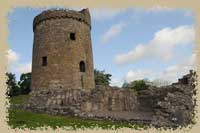 Orchardton Tower is the only round tower house in Scotland. There are a few round tower houses (not just towers, these are large residences) in Ireland (Nenagh comes to mind), but these are pretty rare. Building "in the round" is not terribly easy. This stout little tower looks quite comfortable, actually. Good sized, and other than the problems of trying to furnish a round room, it would be quite nice. About the same size (in square footage) as our first house. Small, but not terribly cramped.
Orchardton Tower is the only round tower house in Scotland. There are a few round tower houses (not just towers, these are large residences) in Ireland (Nenagh comes to mind), but these are pretty rare. Building "in the round" is not terribly easy. This stout little tower looks quite comfortable, actually. Good sized, and other than the problems of trying to furnish a round room, it would be quite nice. About the same size (in square footage) as our first house. Small, but not terribly cramped.
A house is a house is a...vila?
I can't quite get a feel for houses here in Scotland - many of the places we stay are these grand old Georgian or Victorian houses, sprawling and with dozens of rooms. These are not really representative of housing in Scotland today, of course, but an awful lot of them remain standing. They can be enormous, even if the individual rooms are rather small. The average house here is a small bungalow or attached villa, and they are much smaller than what is considered and 'average" house in the US nowadays. Then again, the average house size in the US has grown dramatically in the last few decades. Where our parents grew up in houses that were about 1000 square feet, we're now unhappy in anything less than 1800 or sometimes 2000. We want three or four bedrooms and baths. I grew up in a three bedroom house with one bathroom. That's almost unheard of now. I have to believe that the same sorts of rules apply here. But then again, with all the names and such of house types that show up in real-state ads here, I'm confused as to what to compare to.
Bungalow I get - small, standalone house. Attached Villa - row house or duplex. Detached home - a standalone house . Detached Villa - a larger standalone house. Estate house - house with substantial grounds. I think I've got the definitions right. There are a lot more attached houses here -- town houses, row houses, duplexes -- than I'm used to seeing. This is one area where the terminology is so completely different that I just can't get my head around it. It shouldn't be that hard. One of the things that we HAVEN'T noticed here is the residential development where every single house is exactly the same, like we did in Ireland. Some of the condos that are going up are awfully similar, but the styles have enough variation that they are noticeably different, instead of having to rely on house numbers to differentiate between the two-story white houses with black shutters and green doors and one tree in the yard. Some of those developments were a bit eerie. Here, the houses might be similar, but there is less new development, I think, to incorporate the Stepford Home model.
Politeness adventures - good and bad
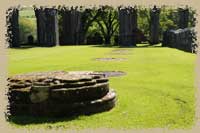 When we arrived at Dundrennan Abbey, the custodian was mowing the grass, but other than that no one was at the site except for an older gentleman standing dead-smack in the middle of the main entrance making a pencil drawing. He seemed oblivious to anyone else, including a polite 'pardon me…' and we debated having to squish past him. IN the end, we just walked around the end wall, but other than acknowledging that we were there, he didn't budge an inch. Obviously engrossed in his drawing, but…right in the middle of the doorway?
When we arrived at Dundrennan Abbey, the custodian was mowing the grass, but other than that no one was at the site except for an older gentleman standing dead-smack in the middle of the main entrance making a pencil drawing. He seemed oblivious to anyone else, including a polite 'pardon me…' and we debated having to squish past him. IN the end, we just walked around the end wall, but other than acknowledging that we were there, he didn't budge an inch. Obviously engrossed in his drawing, but…right in the middle of the doorway?
I have learned, however, that the common phrase we American's use when trying to pass through a crowded room -- Excuse Me! -- should instead be 'pardon me' or 'pardon', or every just 'sorry' all over the UK. Excuse me means you passed gas or did something personally rude, or it's a sarcastic 'get the hell out of my way!' statement. Then again, if you bump into someone here in Scotland, they're going to apologize to YOU, no matter who was at fault. Barrel into someone at full speed and they'll be stammering 'sorry! So sorry!' even as they try to pick themselves up off the pavement. It's completely ingrained response, apparently. Katie Fox in her book Watching the English said that she did a week long experiment where she purposefully bumped into people (and she said it was about the hardest thing she'd done, other than queue jumping) and every single English person said they were sorry first. A few foreign tourists shouted 'Hey!' or 'Watch out!', but the English? 'Sorry! I'm sorry!' At any rate - be careful of your usage of 'excuse me'!
Anyway. The abbey is huge, and some of the outbuildings are remarkably complete. Mark kept laughing at me for looking at the guidebook, turning in small circles, staring quizzically around and trying to reorient myself. Sometimes I have to see the blueprint to make all the piles of foundation stones make sense. I an usually pick out the main pieces, but figuring out how the site would have looked when everything was "whole" is hard sometimes.
Macllelans Tower is another of the "best preserved" set - it stands in perfectly manicured grounds in the town, so it's hard to imagine how big the castle walls would have been.
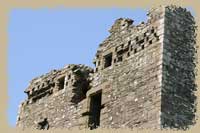 Getting to Threave Castle it a bit more complicated -- first you have to walk for about half an hour to get to the jetty, and then take a little boat across the lock to the island. Historic Scotland has actually done a good job of setting up the walkways, but it's obvious that they had some issues with permission to cross fields an such, since it's an out of the way path. We ended up on the boat with a young American couple and an older guy (we figure the father of one or the other of them) -- they had been in the UK for 8 days and were heading back today, and were quite put out that the walk and boat took so long. They seemed to enjoy being there, but were not happy with the "open at 10 close at 5" way of things here. I admit, it is a bit frustrating for us, too -- although a lot of the things we look at have no opening times at all. If we were on a short timeline, it would probably be more of an issue.
Getting to Threave Castle it a bit more complicated -- first you have to walk for about half an hour to get to the jetty, and then take a little boat across the lock to the island. Historic Scotland has actually done a good job of setting up the walkways, but it's obvious that they had some issues with permission to cross fields an such, since it's an out of the way path. We ended up on the boat with a young American couple and an older guy (we figure the father of one or the other of them) -- they had been in the UK for 8 days and were heading back today, and were quite put out that the walk and boat took so long. They seemed to enjoy being there, but were not happy with the "open at 10 close at 5" way of things here. I admit, it is a bit frustrating for us, too -- although a lot of the things we look at have no opening times at all. If we were on a short timeline, it would probably be more of an issue.
But -- beautiful weather, lovely loch, neat castle -- it's worth part of an afternoon, I think The castle is pretty start, and Mark spent the whole time trying to figure out why James VI insisted on adding the fortifications on the leeward side of the castle. They were hastily added, and we didn't know enough about the siege of he castle to figure it out. Threave was besieged twice and surrendered twice (hey, good record!), although the walls were never actually breached. Each time, the people in the castle just gave up. - and walked away. I'm still not sure why it's of such strategic importance - I think the siege and evacuation were for political reasons, not military ones.
It was actually getting hot as we walked back to the car - luckily we have air conditioning in the rental (hey, not such a rare thing to NOT have it, btw. Make sure you ask when you rent a car. You'll have a much easier time renting a car in Scotland if you can drive a stick (manual transmission), too -- far more cars there are manual and you'll pay a premium for an automatic transmission in many cases. At least hat's what I saw when I was looking for cars. (We got through AutoEurope).
Seeing things in context
We drove right past Corra Castle (Or Corre, it's a bit hard to read) by the side of the road. Mark is getting very, very good at the u-turn procedure and I jumped out to take a few pictures of the very small tower. Based on the end gable, the walls are at least 10' thick. Pretty impressive.
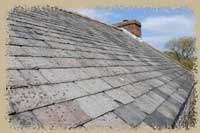 A much more preserved tower at Drumcoltran is also in a small farmyard, with a carefully fenced access path to get inside. It was rather strange, the fence and pathway and gate, and I'm not sure whether it was the requirement from Historic Scotland or the farm owner. It does keep people out of the farmyard proper, and perhaps there's a safety issue with having people wandering all over with livestock and farm implements. The historic preservation societies here are quite powerful, and I have a feeling that if you have a listed building on your property, you have a fairly limited range of options. You can't damage the building, or change it, and I imagine there are some penalties for not doing at least basic maintenance. So Historic Scotland steps in, and they pick up the tab for keeping the building standing, and in return, you grant access through your land and learn to tolerate the parked cars and visitors. That way, everyone wins - the building doesn't fall down on the farmyard since HS maintains it, and HS gets free access. It seems to work out ok.
A much more preserved tower at Drumcoltran is also in a small farmyard, with a carefully fenced access path to get inside. It was rather strange, the fence and pathway and gate, and I'm not sure whether it was the requirement from Historic Scotland or the farm owner. It does keep people out of the farmyard proper, and perhaps there's a safety issue with having people wandering all over with livestock and farm implements. The historic preservation societies here are quite powerful, and I have a feeling that if you have a listed building on your property, you have a fairly limited range of options. You can't damage the building, or change it, and I imagine there are some penalties for not doing at least basic maintenance. So Historic Scotland steps in, and they pick up the tab for keeping the building standing, and in return, you grant access through your land and learn to tolerate the parked cars and visitors. That way, everyone wins - the building doesn't fall down on the farmyard since HS maintains it, and HS gets free access. It seems to work out ok.
One of the interesting notes about Drumcoltran is that, of all the towers we've seen, it is probably the one in the most "realistic" setting -- smack dab in the middle of a farm, with barns and byres attached, with pastures out back and outbuildings stuffed with farm tools and straw bales. These are farm houses, before anything else, and if you got rid of the electrical wires, it probably doesn’t look to different today as it did when it was built. Most of the time they look like they've been dropped in place and the surrounding buildings no longer exist. It's rather nifty.
A little further on and I snapped a picture of what I think is a tower house from the road. My notes says "hills", but to be honest, I'm not sure what it was. We managed to drive around two sides and no obvious access was apparent. As we go further on in the vacation, my notes tend to get a bit more cryptic and sometimes I have a hard time pinpointing things. Hmph.
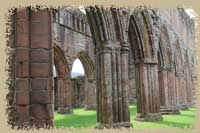 There were a bazillion people at Sweetheart Abbey -- at least the car park was completely full, but most people were in the church gardens, relaxing in the sun and not in the Abbey itself. Inside, it was quite and peaceful and we spent most of the time alone. When we were here before, we pulled up late in the afternoon and we were the only car in the park, and the only people in the Abbey. Having the place to ourselves is quite nice. I really like this abbey - all red sandstone and green velvety grass. I wish we had been able to get a few clearer exterior shots of the church, though, without the parked cars.
There were a bazillion people at Sweetheart Abbey -- at least the car park was completely full, but most people were in the church gardens, relaxing in the sun and not in the Abbey itself. Inside, it was quite and peaceful and we spent most of the time alone. When we were here before, we pulled up late in the afternoon and we were the only car in the park, and the only people in the Abbey. Having the place to ourselves is quite nice. I really like this abbey - all red sandstone and green velvety grass. I wish we had been able to get a few clearer exterior shots of the church, though, without the parked cars.
Cutting off your nose to spite your face
We ran into an English couple (well, she was. He was Spanish or Greek, perhaps?) who had just bought a caravan and were driving around in Scotland. They were peering gin through the gate, but were adamant that they "refused to pay money" to see these things. They actually said that they had already "drive too far to pay an entry fee". It was kind of strange. When I met them at the gate and told them that the entrance was on the other side of the church (assuming they had just come at it the wrong way) I was told that it was going to cost money and they got rather huffy about it. Well, yeah, it does cost money to get in to most of the sites -- someone has to pay to maintain these places and make sure they stand. We joined Historic Scotland and National Trust for this trip, to support the restoration of the buildings and the addition of new ones. It didn't look like they were going to have trouble with the four pound entry fee, but they were adamant that they would not pay to go in. Ooookay. I don’t' understand that at all. If you've already gone out of your way to see something, and spent a tidy sum of money to get there, not going in because it's going to cost another few pounds seems really weird. I can understand budgeting for that sort of thing, of course, but to avoid it altogether? I guess.
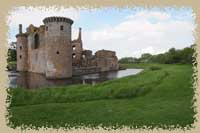 I love Caerlaverock Castle, it was one of my favorites from our lat visit -- it's just such a photogenic castle with those two big towers and the moat. We walked around the ring wall and took more pictures -- although the sun didn't cooperate at all. IT was actually gorgeous weather, and blue skies, but the clouds insisted in sitting still for once, and blocking the sun. Hey, it's a nice change from the turbo charged cloud movement that there normally is. Honestly, I've never been anywhere where the clouds moved SO FAST. Look up at them sometimes and you actually get vertigo, they are scudding across the sky so quickly. (And that's not always on the days with 80 mph winds, either). It was lovely and bright but a bit cloudy. I still love the place. There is something terribly romantic about an actual moated castle.
I love Caerlaverock Castle, it was one of my favorites from our lat visit -- it's just such a photogenic castle with those two big towers and the moat. We walked around the ring wall and took more pictures -- although the sun didn't cooperate at all. IT was actually gorgeous weather, and blue skies, but the clouds insisted in sitting still for once, and blocking the sun. Hey, it's a nice change from the turbo charged cloud movement that there normally is. Honestly, I've never been anywhere where the clouds moved SO FAST. Look up at them sometimes and you actually get vertigo, they are scudding across the sky so quickly. (And that's not always on the days with 80 mph winds, either). It was lovely and bright but a bit cloudy. I still love the place. There is something terribly romantic about an actual moated castle.
Unavailable Real Estate
We swerved into the Comlongon Castle Hotel parking lot for a picture - not much left of it that's very castle-y, really, but it's quite pretty and looks like a nice hotel. Too pricey for our tastes today. So we only paused for a moment before looking for Hoddom castle, which I was determined to see simply because the note I have say it is 'abandoned, and in the middle of a caravan park'. I was really surprised, once we found it -- Hoddom Castle is HUGE and sitting derelict in the back of the park behind the take-out chip shop. We drove into the park (not remembering that it is a holiday weekend) and were almost overrun by the hundreds and hundreds of caravans and campers and tents and people barbecuing.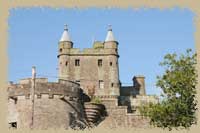 The castle is very cool (as in, wow - I could move in there in a minute) but it has been abandoned for a long time and some of the buildings have been purposefully damaged/destroyed and reused. The windows are all boarded up, the roof Is in place, but it's obviously been left to moulder away and slowly fall down. I wonder if it has ever been for sale?
The castle is very cool (as in, wow - I could move in there in a minute) but it has been abandoned for a long time and some of the buildings have been purposefully damaged/destroyed and reused. The windows are all boarded up, the roof Is in place, but it's obviously been left to moulder away and slowly fall down. I wonder if it has ever been for sale?
Hoddom castle is sitting derelict in the back of a caravan park. We drove in (not realizing it was a holiday weekend) and were almost overrun by the hundreds of caravans and campers and tents and people barbecuing, etc. The castle is really, really cool (as in, I could move there!), but it's been abandoned for a long time. The windows are boarded up, mostly, and there is still a roof on it, but it's obviously been left to slowly fall down. It was last used to house soldiers in WWII, and after that they demolished all the Victorian additions and revealing the tower house and it's "Scottish Baronial" additions. I wonder if it's for sale?
I wonder who I can ask?

